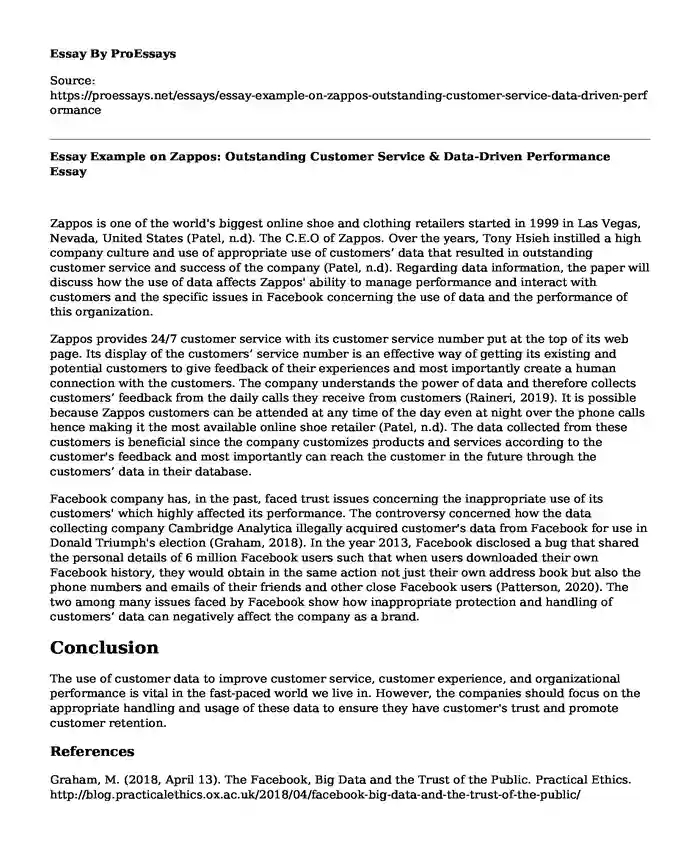Zappos is one of the world's biggest online shoe and clothing retailers started in 1999 in Las Vegas, Nevada, United States (Patel, n.d). The C.E.O of Zappos. Over the years, Tony Hsieh instilled a high company culture and use of appropriate use of customers’ data that resulted in outstanding customer service and success of the company (Patel, n.d). Regarding data information, the paper will discuss how the use of data affects Zappos' ability to manage performance and interact with customers and the specific issues in Facebook concerning the use of data and the performance of this organization.
Zappos provides 24/7 customer service with its customer service number put at the top of its web page. Its display of the customers’ service number is an effective way of getting its existing and potential customers to give feedback of their experiences and most importantly create a human connection with the customers. The company understands the power of data and therefore collects customers’ feedback from the daily calls they receive from customers (Raineri, 2019). It is possible because Zappos customers can be attended at any time of the day even at night over the phone calls hence making it the most available online shoe retailer (Patel, n.d). The data collected from these customers is beneficial since the company customizes products and services according to the customer's feedback and most importantly can reach the customer in the future through the customers’ data in their database.
Facebook company has, in the past, faced trust issues concerning the inappropriate use of its customers' which highly affected its performance. The controversy concerned how the data collecting company Cambridge Analytica illegally acquired customer's data from Facebook for use in Donald Triumph's election (Graham, 2018). In the year 2013, Facebook disclosed a bug that shared the personal details of 6 million Facebook users such that when users downloaded their own Facebook history, they would obtain in the same action not just their own address book but also the phone numbers and emails of their friends and other close Facebook users (Patterson, 2020). The two among many issues faced by Facebook show how inappropriate protection and handling of customers’ data can negatively affect the company as a brand.
Conclusion
The use of customer data to improve customer service, customer experience, and organizational performance is vital in the fast-paced world we live in. However, the companies should focus on the appropriate handling and usage of these data to ensure they have customer's trust and promote customer retention.
References
Graham, M. (2018, April 13). The Facebook, Big Data and the Trust of the Public. Practical Ethics. http://blog.practicalethics.ox.ac.uk/2018/04/facebook-big-data-and-the-trust-of-the-public/
Patel, N. (N.d). Tony Hsieh, Zappos, and the Art of Great Company Culture. Neil Patel. https://neilpatel.com/blog/zappos-art-of-culture/
Patterson, D. (2020, July 30). Facebook's Data Privacy Scandal: A Cheat Sheet. The Tech Republic. https://www.techrepublic.com/article/facebook-data-privacy-scandal-a-cheat-sheet/
Raineri, S. (2019, May 30). Zappos Embraces Digital Tech, Customer Service for Success. The Balance Small Business. https://www.thebalancesmb.com/zappos-uses-technology-and-operations-to-be-successful-2533530
Cite this page
Essay Example on Zappos: Outstanding Customer Service & Data-Driven Performance. (2023, Nov 19). Retrieved from https://proessays.net/essays/essay-example-on-zappos-outstanding-customer-service-data-driven-performance
If you are the original author of this essay and no longer wish to have it published on the ProEssays website, please click below to request its removal:
- Paper Example on Beatle Rock Band
- Elements of Painting Paper Example
- Essay Sample on Apple Inc.'s Innovative Culture: Achieving Industry Leadership
- Essay Sample on Marina Bay Sands & Gar: A Model of Sustainable Landscape Architecture Design
- Paper Example on Measuring Strategies for Improved Organizational Performance
- Movie Analysis Essay on Frontline
- Explore Instagram: Social Media App for Photo & Video Sharing - Essay Sample







